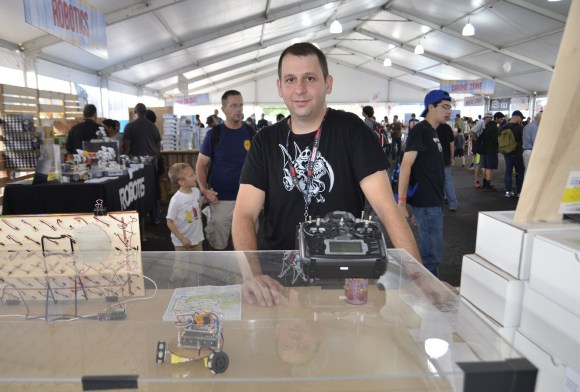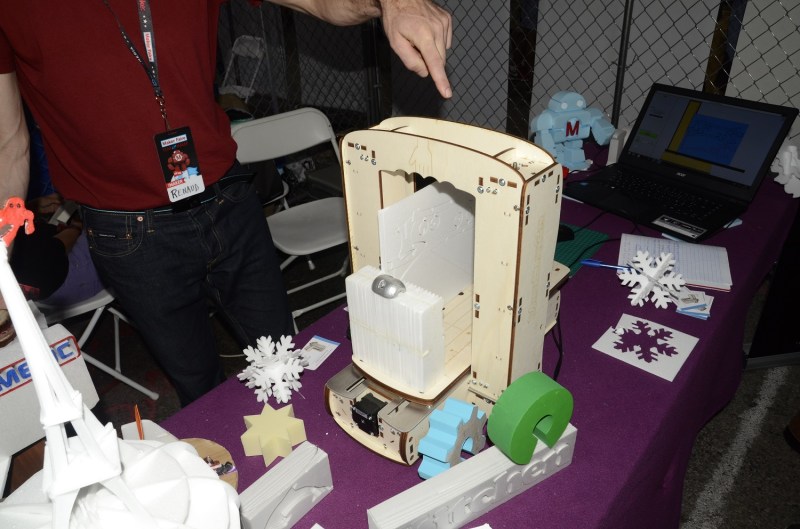You’d think we would be done with the World Maker Faire posts by now, but no! We keep looking at our memory cards and finding more awesome projects to write about.
[Renaud Iltis] flew over from France to show off MiniCut2D, his CNC hot wire foam cutter. MiniCut2D uses X and Y, and Z st epper motors much like a 3D printer. Rather than print though, it pulls a heated nichrome wire through styrofoam. Foam cutting is great for crafts, but it really takes off when used for R/C aircraft. [Renaud] was cutting some models out of Depron foam in his booth. [Renaud] has set up FrenchFoam.com as a central location for users to upload and share designs in DXF format.
epper motors much like a 3D printer. Rather than print though, it pulls a heated nichrome wire through styrofoam. Foam cutting is great for crafts, but it really takes off when used for R/C aircraft. [Renaud] was cutting some models out of Depron foam in his booth. [Renaud] has set up FrenchFoam.com as a central location for users to upload and share designs in DXF format.
One of the neater features of MiniCut2D is that it can be loaded with a stack of foam boards to make several cuts at once. Not only is this a time saver when cutting repeating designs like wing ribs, but it also ensures the cut pieces are identical. Hey, even CNCs make mistakes once in a while.
Omniwheel Robot

In the MakerShed booth, we found [Victor Aprea] showing off Wicked Device’s new product, the Omniwheel Robot. Omniwheel utilizes a holonomic drive with omnidirectional wheels. The kit comes with a Nanode Zero, Wicked Devices’ own Arduino Uno clone, a motor control board, 3 motors, 3 omnidirectional wheels, and a whole list of hardware. The only thing needed to complete the kit is a radio control unit and receiver. Omniwheel may be simple, but we found driving it around to be mesmerizing – and a bit challenging. It’s a good thing [Victor] brought that plexiglass cover, as we bumped it a few times.
We’d love to see one of these little bots with a couple of sensors and autonomous control. If you build one, make sure to post it to Hackaday.io!
















Hot foam cutter, thin wood body? Cool bot but at least make the body out of something resistant to catching fire.
Consider all the 3D printers made with wooden frames. The temperatures they use are magnitudes higher than the temperatures needed to heat the nichrome wire used to cut through foam.
Nichrome wire is much longer and much more exposed. Foam too is combustible, it is literally being melted to cut through it. Melting ABS happens at
Nichrome wires can hit 2000F. I doubt an average hot end is hitting much over 500 to 600F and that’s generally inside the heating element, which is then heating up plastic, which is extruded and very quickly cooling down. ABS melts at 221F.
Pretty sure that hot foam cutters are significantly hotter and more likely to be a problem when you use wood in close proximity to the cutting wire.
Bah, meant to post “melting ABS happens at 221F.”
@Waterjet
I have my own foam cutter that uses a fine gauge nichrome wire. I don’t need the wire to hit 2000F. I need the wire to be as cool as possible yet still allow for it to pass through foam. The cooler it is and the slower it moves through the foam the more accurate the cut. Since I use it to cut foam cores for carbon fiber composite radio controlled hotliner glider wings (which reach 150+ miles per hour), accuracy is important.
While I don’t know (nor really care) what temperatures the nichrome wire reaches, I do know it’s not even remotely close to 2000F. 2000F is likely nichrome’s limit. Beyond white hot. My nichrome wire doesn’t even turn red. If I grabbed the wire with my hand, it would take a second or two to cause damage. I could set the heated wire on a piece of wood for an hour and it wouldn’t leave a mark (I speak from experience).
The foam I use doesn’t combust. Coincidentally, the best foams to use for making wing cores tend to be the foams used for insulating homes. When exposed to open flame these foams tend to shrivel up and turn into gooey puddles since homes are things people want combusting.
ABS’s glassing point is around 105C (or 220F). For 3D printing though, I set my hot end much higher than that. If I print ABS with my hot end set to anything less than 220C (428F) the best I can hope for is a clogged nozzle.
While you’ve shared some good facts, they’re not very useful in this context (that of suggesting that a wood framed foam cutter is more dangerous than a wood framed 3D printer).
“MiniCut2D uses X, Y, and Z stepper motors”
Fairly certain that this machine does not have three axis control. It is moving a line in a 2 dimensional plane.
There are some foam cutters that allow independent control of the hot wire ends to allow cutting things like cones and tapered airplane wings. Such as:
http://www.instructables.com/id/Make-a-CNC-Hot-Wire-Foam-Cutter-from-parts-availab/
Even then, it is not truly 3 d because you are still moving a line in a 2 d plane, albeit with control of the angle.
Just remember, it’s only a matter of voltage (and a mineral oil bath) that separates a hot wire cutter from a wire EDM machine.
And a water deionizing and filtration system.
Doh – you’re right. X and Y (from the perspective of the workpiece) it is.
Cutting foam with a hot wire emits a really nasty smell, probably should be done with some sort of fume extraction.
Most people call them lungs.
Interestingly enough there wasn’t any detectable smell from the machine – though you’re absolutely right, it shouldn’t be done in an enclosed area. I did ask [Renaud] about cutting EPP foam, and while he wants to, he said the fumes produced during cuts were too strong.
Thank you Adam, it was very nice to meet you at the Maker Faire and introduce you to the project. Just for information, the officiel website is http://www.minicut2d.com
Fire risks are very low, I did some tests with much higher temperature than what I use on MiniCut2d and I never managed to ignite the plywood.
The MiniCut2d must be used in a ventilated room. The cutting time is short and the groove of the wire is 1 mm, there is little fumes with the polystyrene (the material that must be used). For the EPP it’s different, I’m working on a version of the software that allows you to cut it out (for the RC models), but it will be an “expert” mode and it will be necessary to warn the users.
Best regards, Renaud.